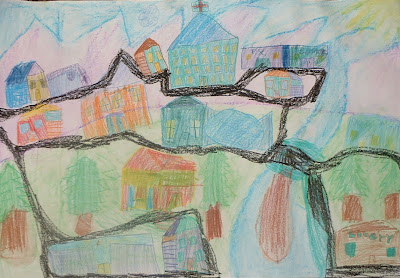~Using the pond behind the school to teach ecosystems and collect data.
~Graphing the sunrise and sunset times over the course of a year for your specific latitude.
~Interviewing local lawmakers to understand the political process.
~Visiting a local business to facilitate an understanding of supply and demand.
~ Inviting a local artist to teach their technique and perspective.
Place-based is the belief that teaching happens most effectively through use of the local culture, politics, art, environment, economy, geography etc.... creating a concrete context in which students can build connections to the content being taught. It emphasizes the idea that knowledge spirals and builds upon itself to produce a greater global understanding. Grounded in the philosophy is the notion that experiential learning and activating the learners' prior knowledge facilitates an optimal learning experience.
In a society globalized by the Internet, television, various print media, and trade, we often lose sight of what is immediately around us. We take our local environment for granted, allowing ourselves to be unaware of simple things that effect our everyday lives, such as where our food comes from. Fortunately many have realized this disconnect and have put forth great efforts to study and mend it at the greater social level, specifically in education. Gary Snyder the famous poet, philosopher and environmental activist has addressed this concern through volumes of work. In his book A Place in Space he suggests, “Knowing who we are and knowing where we are intimately linked.” David Orr, Gregory Smith and other educators actively promote “place-based” education, which is described as “grounding education in local phenomena and students’ lived experience.”
PBE is beneficial to all students, but it's effects are magnified when employing it with children in low income, impoverished areas and students who English is not their first language. A field trip to the market to label groceries is far more effective in building vocabulary that will be retained then only looking at cartoons on flashcards. Taking samples from a local creek and charting the data, not only engages the senses, but also allows a student to internalize that information, and provides them with the ability to understand the work going on in cutting edge research facilities around the world.
It is the epitome of the microcosm / macrocosm relationship. If you understand what is happening in your neighborhood community council meetings, you can translate that knowledge to comprehend what is occurring at a United Nations meeting.
In 1899, in his book The School and Society, John Dewey summed up the major problem facing the institution of education that still exists today, when he wrote "... the great waste in school comes from the child’s inability to utilize the experiences he gets outside the school in any complete and free way within the school itself; while at the other hand, he is unable to apply in daily life what he is learning at school."
Teach Locally, Think Globally.
 |
| A self portrait of a student through a landscape painting. Each landmark is a place important to her own life in Fairbanks, Alaska. |
